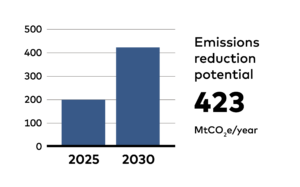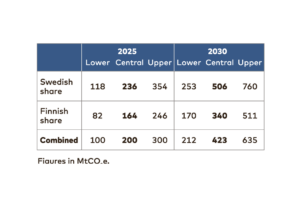Climate impact
Sweden and Finland cover 11.9% and 9.3% of their transport energy use with biofuels, respectively. As most of the fuels are used in road transport, the share there is higher. Both countries rely predominantly on biodiesel, but Sweden also uses some bioethanol and biogas.
If other countries were to reach the same share of biofuels in transport as Sweden, the net abatement potential would be approximately 510 Mt in 2030. The Finnish case gives a smaller potential. The figures assume that biofuels reduce emissions by 60% on an average compared with fossil fuels.


Success factors
Sweden and Finland have reached relatively high shares of biofuels in road transport. The primary policy has been a blending obligation: regulation requiring fuel companies to provide a growing share of biofuels in the fuels they distribute.
In Finland, taxation is based on the energy content and carbon emissions of fuels. As no emission taxes are levied on biofuels, this provides an added incentive.
In Sweden, local governments have been the driving force behind the introduction of biogas. Local authorities have provided both feedstock from organic waste and sewage as well as demand by requiring the use of biogas in public vehicles, such as buses and garbage trucks.
“Waste- and residue-based biofuels are generally more sustainable.”
Costs
A weighted average of biofuels gives an abatement cost of 1.9 $/tCO2. First generation biofuels have a slightly negative abatement cost per ton, while second generation biofuels have a slightly larger, but positive abatement cost. The total cost of implementing the solution would then be approximately $800 million in 2030.


Co-benefits
While there is a variety of different biofuels and feedstocks, some of them can provide multiple co-benefits, such as
- reducing dependence on fuel imports
- cutting local air pollution
- creating local jobs
Barriers and drivers
One of the main barriers to the introduction of biofuels at scale is the concern about sustainability (see section Is biomass use sustainable? in the report). Different feedstocks have wildly varying impacts on climate, biodiversity and food security. Waste- and residue-based biofuels are generally more sustainable than first generation biofuels made from dedicated crops.
The availability of sustainable biomass is limited with current technologies. Improvements in technology (such as more efficient conversion processes), new feedstocks (such as algae and community-based crops grown on degraded lands) and regulation to limit harmful impacts (such as indirect land-use change, ILUC) are likely to increase the potential in the future.
Although enough sustainable biomass may be made available, limited resources may need to be prioritised. For the time being, there are very few lowcarbon options available for aviation, shipping and heavy duty road transport. It may therefore make sense to electrify the car fleet (see Electric vehicles) and dedicate most of biofuels to heavy transport.
Existing gas and diesel cars can usually tolerate a 10–20% share of biofuels. To achieve higher shares, either new cars need to be introduced or drop-in biofuels selected, allowing the use in existing cars.









RELATED SOLUTIONS